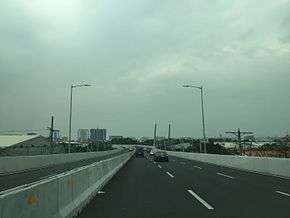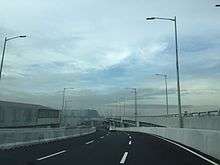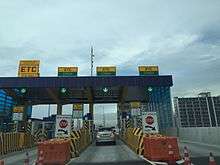NAIA Expressway
| |
|---|---|
| NAIA Skyway | |
 NAIA Expressway, looking south towards NAIA Road from Andrews Avenue in Pasay | |
| Route information | |
| Length | 11.6 km (7.2 mi) |
| Existed | September 22, 2016 – present |
| Major junctions | |
| West end | Jose Diokno Boulevard in Parañaque |
| East end |
|
| Location | |
| Major cities | Pasay, Parañaque |
| Highway system | |
|
Roads in the Philippines | |
The NAIA Expressway (NAIAEx, NAIAx and Ninoy Aquino International Airport Expressway) [1] is an 11.6-kilometer (7.2 mi) elevated expressway system in Metro Manila, Philippines, which links the Metro Manila Skyway to the Ninoy Aquino International Airport (NAIA) and Entertainment City. It runs along Andrews Avenue, Electrical Road and NAIA Road connecting the Skyway to Ninoy Aquino Avenue, Macapagal Boulevard, Jose Diokno Boulevard and the Manila–Cavite Expressway. The roadway is the first airport expressway in the Philippines which opened in September 2016.[2] It is located in the cities of Pasay and Parañaque. The entire expressway is designated as the Expressway Route 6 (E6) of the Philippine expressway network.
Route description
From the Sales Interchange (NAIA exit) of the Metro Manila Skyway, the expressway heads to the southwest and runs along Sales Road across Villamor Airbase and Newport City. It then curves to the northwest on Andrews Avenue towards the entrance to NAIA Terminal 3 and continues along the northern perimeter of the airport towards Electrical Road near NAIA Terminal 4. From here, it makes a turn to the south and runs parallel to Domestic Road on the east towards the NAIA Road junction. From this junction, the expressway branches into two, with one traversing eastwards to NAIA Terminals 1 and 2, while the other continues westwards to Entertainment City and the Manila–Cavite Expressway.
History
.jpg)
Construction on the 1.6-kilometer (0.99 mi) NAIA Expressway Phase 1 (NAIA Terminal 3 Exit of the Metro Manila Skyway) was completed in 2009.[3] It provided an entry/exit ramp to the then newly-opened NAIA Terminal 3 and Resorts World Manila. On January 2, 2014, construction began on Phase 2 of the NAIA Expressway. It included a 7.15-kilometer (4.44 mi) extension of the expressway all the way to Macapagal Boulevard in Entertainment City, Parañaque via Andrews Avenue, Electrical Road (west of Domestic Road) and NAIA Road.[4][5]
On September 22, 2016 at exactly 12:01 AM (PST), the second phase of the airport expressway from Macapagal Boulevard to NAIA Terminals 1 and 2 was opened to all motorists and airport passengers rushing to their flights in order to avoid the traffic lights of each intersection along NAIA Road. The opening of the elevated airport expressway was led by Department of Public Works and Highways Secretary Mark Villar. According to Department of Transportation Secretary Arthur Tugade, the toll collection at the NAIAEx will begin on October 22 exactly 1 month after the opening of the airport tollway.[2]
On December 21, 2016 at exactly 6:00 AM (PST), the Entertainment City-NAIA Road-SLEX-Skyway segment (including the access ramp connecting to Terminal 3) of the airport expressway was opened to all motorists because of the Christmas rush.
On December 28, 2016, the access ramps to Manila-Cavite Expressway or CAVITEx has been also opened to all motorists coming from the province of Cavite and Las Piñas for easier access to Terminals 1, 2 and 3 and vice versa.
On June 2, 2017, NAIAx was fully opened to all motorists.
Technical specifications

- Name: NAIA Expressway or NAIA Skyway
- Concession Holder: Vertex Tollways Development, Inc.
- Operator: Vertex Tollways Development, Inc.
- Concession starting date: 2013
- Concession ending date: 2043
- Length: 11.6-kilometer (7.2 mi)
- Highway exits: 8
- Exit ramps: 2 (Villamor, NAIA 3)
- Toll plazas: 1
- Height:
- Spurs: none
Tolls

The expressway uses a barrier toll system, where toll collection is done on toll barriers in a fixed rate. The eastbound lanes of NAIAx employ toll collection at exit points and a common toll plaza in front of NAIA Terminal 3, while the westbound lanes employ toll collection only in the entry points. The expressway uses the Autosweep RFID electronic toll collection system, shared with Skyway and SLEX.
Phase 1 (Skyway)
| Class | Toll |
|---|---|
| Class 1 (Cars, Motorcycles, SUVs, Jeepneys) |
₱20.00 |
| Class 2 (Buses, Light Trucks) |
₱40.00 |
Phase 2 (NAIAx)
| Class | Short Segment | Full Route |
|---|---|---|
| Class 1 (Cars, Motorcycles, SUVs, Jeepneys) |
₱35.00 | ₱45.00 |
| Class 2 (Buses, Light Trucks) |
₱69.00 | ₱90.00 |
| Class 3 (Heavy Trucks) |
₱104.00 | ₱134.00 |
Exits
Exits are numbered by kilometre post, with Rizal Park in Manila designated as kilometre 0.
| Province | City/Municipality | km | mi | Exit | Name | Destinations | Notes | |
|---|---|---|---|---|---|---|---|---|
| Pasay | Sales Interchange. East end of expressway. | |||||||
| Villamor toll plaza (westbound) | ||||||||
| Westbound exit and eastbound entrance | ||||||||
| Newport City, Villamor Airbase | Eastbound exit and westbound entrance. | |||||||
| Southbound exit only. | ||||||||
| Directional T interchange. | ||||||||
| Parañaque | Westbound exit and eastbound entrance | |||||||
| Macapagal Boulevard, Seaside Drive | Westbound exit and eastbound entrance. Access to Okada Manila. | |||||||
1.000 mi = 1.609 km; 1.000 km = 0.621 mi
| ||||||||
See also
References
- ↑ DPWH PPP Projects NAIA Archived 2014-11-22 at the Wayback Machine.
- 1 2 "NAIA Expressway finally opening on September 22". ABS-CBN. Retrieved 2016-09-07.
- ↑ "Arroyo inaugurates NAIA expressway before leaving for Korea". GMA News. 30 May 2009. Retrieved 7 January 2017.
- ↑ NAIA Expressway Phase 2 Archived 2011-03-12 at the Wayback Machine.
- ↑ "NAIA Expressway to be operational 2015". BusinessWorld. Retrieved 11 August 2014.
External links
- http://www.gmanews.tv/story/163499/Arroyo-inaugurates-NAIA-expressway-before-leaving-for-Korea Arroyo inaugurates NAIA expressway before leaving for Korea - GMA News report
Coordinates: 14°31′15″N 121°1′21″E / 14.52083°N 121.02250°E
.svg.png)
